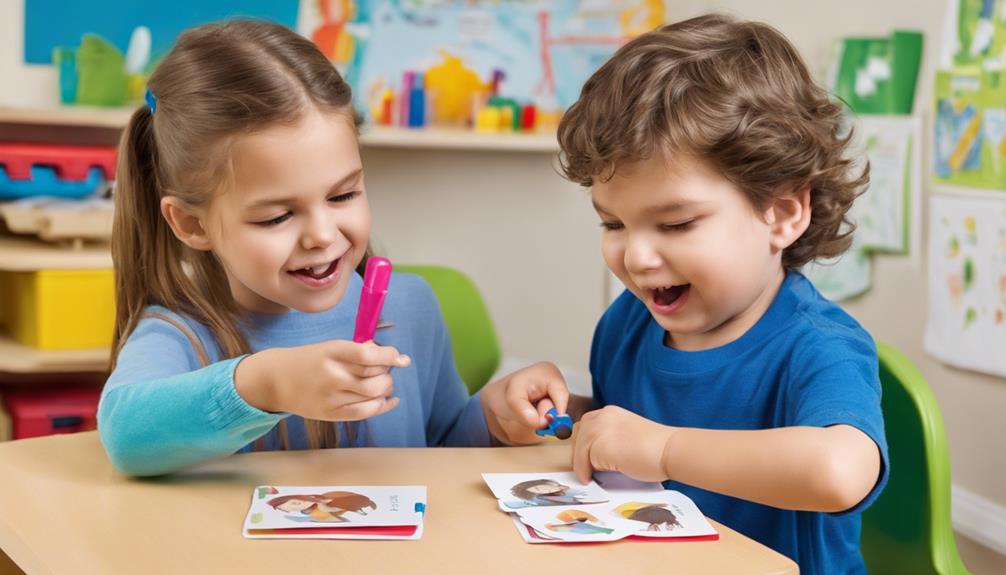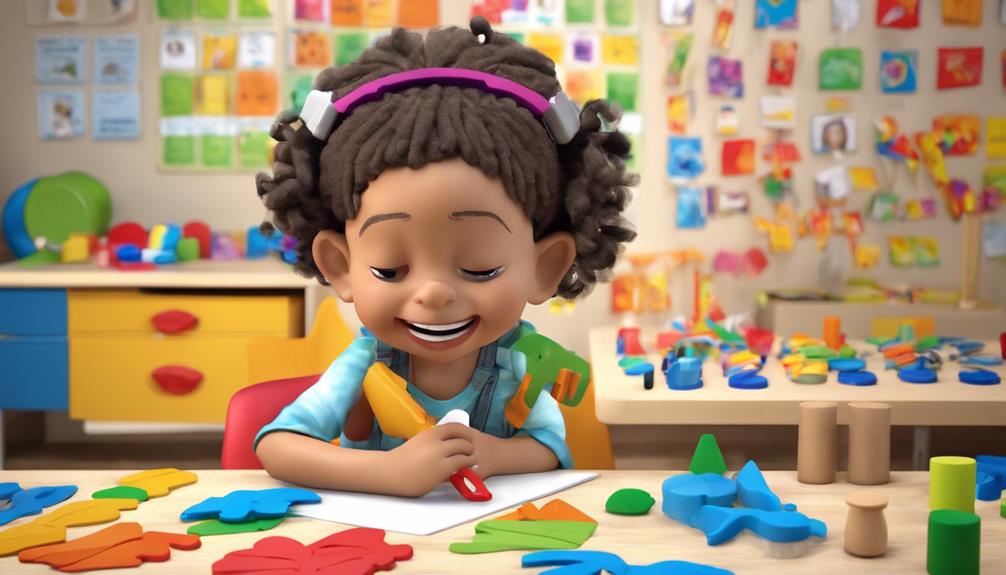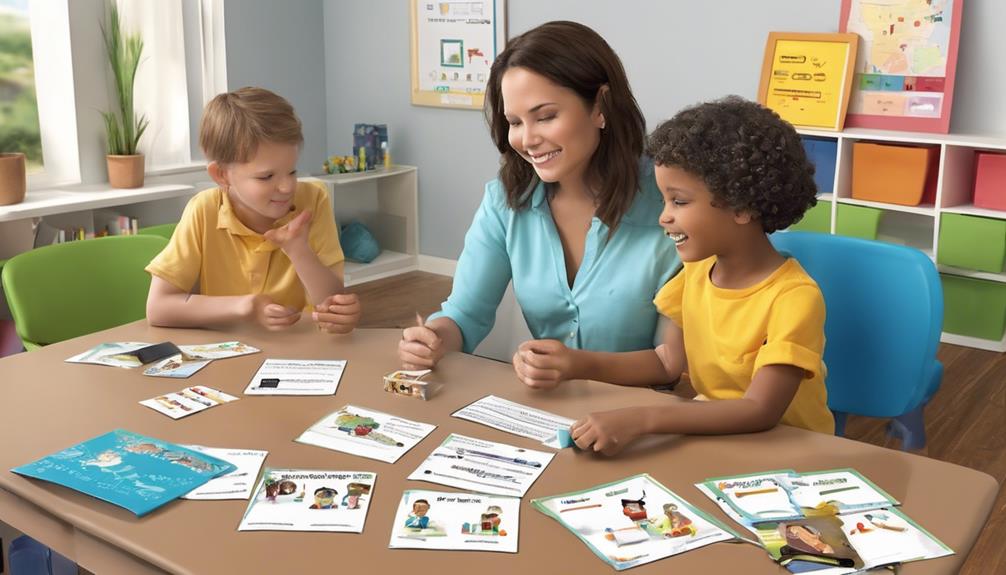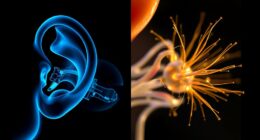As speech therapists, we all strive for optimal outcomes in our sessions, and mastering the 7 Auditory Processing Disorder goals is paramount for success. These goals serve as the cornerstone for effective communication strategies and overall improvement in auditory processing skills.
By honing in on key areas such as auditory discrimination, comprehension, and sound blending, we pave the way for significant progress in our clients' speech therapy journey.
But what lies beyond these fundamental goals? Stay tuned to uncover the intricate details that can truly make a difference in therapeutic interventions.
Key Takeaways
- Customize communication objectives for tailored interventions and progress tracking.
- Enhance sound recognition and discrimination skills for improved auditory processing.
- Develop proficient sound blending through multisensory techniques and phonemic activities.
- Strengthen language comprehension and speech production for effective communication outcomes.
Setting Clear Communication Objectives
In speech therapy for Auditory Processing Disorder (APD), setting clear communication objectives is essential to improve auditory discrimination, comprehension, and speech understanding. By establishing precise goals tailored to address individual needs, we can effectively target areas such as sound processing, auditory memory, and following multi-step directions. These measurable objectives not only help track progress but also enhance crucial auditory processing skills vital for improved communication abilities. Customizing goals to suit specific abilities ensures that interventions are focused and supportive, maximizing success in managing APD symptoms through speech therapy.
In our practice, we emphasize the importance of enhancing listening skills, speech clarity, and sound recognition to achieve functional communication outcomes. By honing in on these key areas, we aim to equip individuals with the tools necessary to navigate the challenges posed by APD. Through setting clear communication objectives, we pave the way for significant advancements in auditory discrimination, comprehension, and speech understanding, ultimately fostering success in speech therapy for Auditory Processing Disorder.
Improving Auditory Discrimination Skills

When improving auditory discrimination skills, we focus on sound recognition techniques and developing listening skills.
These skills are crucial for enhancing phonemic awareness, which is vital for reading and spelling proficiency.
Sound Recognition Techniques
Utilizing sound recognition techniques is essential for enhancing auditory discrimination skills in individuals with Auditory Processing Disorder (APD). These strategies focus on improving auditory processing skills, speech aspects, phonemes, and auditory discrimination skills.
By honing in on these areas, individuals with APD can better grasp complex utterances, engage in conversations, and follow directions effectively. Sound recognition techniques aid in differentiating between sounds, attaching meaning to them, and manipulating phonetic elements accurately.
Speech therapists play a crucial role in implementing these techniques to address auditory processing difficulties, leading to improved receptive language skills and enhanced communication abilities in individuals with APD.
Through targeted interventions, individuals can develop the necessary skills to navigate the challenges associated with APD and improve their overall quality of life.
Listening Skill Development
Enhancing auditory discrimination skills is a key component in the development of listening abilities for individuals with Auditory Processing Disorder. Auditory discrimination involves distinguishing between similar sounds like 'p' and 'b' to enhance listening comprehension, aiding in speech perception and language development.
Speech therapy targets auditory discrimination to help individuals recognize and interpret speech sounds accurately. Improved auditory discrimination skills lead to better understanding of spoken language and enhanced communication abilities.
Developing auditory discrimination is crucial for overcoming challenges in processing auditory information and following verbal instructions effectively.
- Distinguishing between similar sounds enhances listening comprehension
- Speech therapy aids in speech perception and language development
- Recognizing and interpreting speech sounds accurately is crucial
- Improved auditory discrimination skills lead to better understanding of spoken language
- Overcoming challenges in processing auditory information is essential
Enhancing Sound Blending Proficiency
How can we effectively boost sound blending proficiency in individuals undergoing auditory processing disorder (APD) therapy?
Sound blending is crucial for improving phonological awareness, language comprehension, and speech clarity. Enhancing sound blending skills involves combining individual sounds to form words or sentences accurately.
In APD therapy, sound blending exercises focus on blending sounds smoothly and rapidly. Interventions like phonemic awareness activities, repetition exercises, and multisensory techniques are effective for developing sound blending proficiency.
Strengthening Listening Comprehension Abilities

When it comes to strengthening listening comprehension abilities in individuals with Auditory Processing Disorder (APD), focusing on enhancing auditory discrimination and improving sound recognition are crucial points. These aspects play a significant role in helping individuals accurately process and understand auditory information.
Enhancing Auditory Discrimination
Improving auditory discrimination skills is essential for individuals with Auditory Processing Disorder to enhance their listening comprehension abilities. Auditory discrimination involves distinguishing speech sounds like /b/ and /d/, which is crucial for developing language skills and boosting comprehension of spoken language.
Here are five key points to consider when enhancing auditory discrimination:
- Training goals target improving the ability to differentiate subtle sound differences.
- Strengthening auditory discrimination aids in language development.
- Enhanced auditory discrimination helps in distinguishing speech sounds in noisy environments.
- Improved auditory discrimination supports accurate processing of auditory information.
- Developing auditory discrimination skills is vital for effective communication.
Improving Sound Recognition
To strengthen listening comprehension abilities in individuals with Auditory Processing Disorder, enhancing sound recognition skills through targeted speech therapy activities is crucial. Speech therapy focuses on tasks like sound discrimination and auditory memory exercises to improve sound recognition.
By honing these skills, children with Auditory Processing Disorder can better identify and understand subtle differences in speech sounds, aiding in their overall listening comprehension. Developing phonological awareness and the ability to differentiate between similar sounds are key goals in speech therapy for sound recognition.
Successful improvement in sound recognition can significantly enhance communication, academic performance, and social interactions for individuals dealing with Auditory Processing Disorder. Through tailored interventions, speech therapy plays a vital role in empowering individuals to navigate auditory processing challenges effectively.
Developing Effective Speech Production

In developing effective speech production for individuals with Auditory Processing Disorder (APD), a focus on articulation, phonological awareness, and speech clarity is essential. When working on speech production goals for individuals with APD, we aim to enhance their communication abilities through targeted interventions.
- Articulation: Target specific speech sounds and patterns to improve speech intelligibility.
- Phonological Awareness: Enhance the understanding of sounds and their relationship to language for better speech discrimination.
- Speech Clarity: Work on improving speech sound production accuracy to reduce communication breakdowns.
- Prosody and Intonation: Provide strategies to enhance speech pacing, intonation, and prosody for a natural flow of speech.
- Coordination: Strengthen the connection between auditory processing, speech production, and language comprehension to boost overall communication outcomes.
Building Vocabulary and Language Skills

Building vocabulary and language skills in individuals with Auditory Processing Disorder involves incorporating engaging multisensory activities and targeted repetition to enhance word recognition. Language development in speech therapy for APD includes phonological awareness tasks like rhyming and sound segmenting. Storytelling and narrative activities can enhance language comprehension and expression. Visual aids and real-life examples support vocabulary acquisition and language expansion in therapy sessions. Specific language goals such as sentence structure and word retrieval can improve communication abilities in children with APD.
| Multisensory Activities | Repetition |
|---|---|
| Engaging and Interactive | Targeted and Purposeful |
| Stimulates Learning | Enhances Word Recognition |
| Encourages Participation | Reinforces Vocabulary |
| Boosts Language Skills | Strengthens Memory |
Implementing Multisensory Learning Techniques

Enhancing therapy outcomes for individuals with Auditory Processing Disorder involves incorporating multisensory learning techniques that engage multiple senses to optimize information processing. By integrating various sensory modalities such as auditory, visual, tactile, and kinesthetic stimuli, speech therapists can create a more holistic approach to address the unique needs of those with APD.
- Multisensory learning techniques engage multiple senses like hearing, touch, and sight to enhance information processing in individuals with Auditory Processing Disorder (APD).
- These techniques involve combining auditory input with visual, tactile, or kinesthetic stimuli to reinforce learning and memory retention for individuals with APD.
- Implementing multisensory strategies in speech therapy can improve auditory discrimination, sound recognition, and language processing skills in individuals with APD.
- By incorporating multisensory approaches, speech therapists can address the unique sensory needs and preferences of individuals with APD to optimize therapy outcomes.
- Multisensory learning helps individuals with APD strengthen neural connections, enhance sensory integration, and improve overall communication abilities through varied sensory experiences.
Frequently Asked Questions
How to Treat Auditory Processing Disorder in Speech Therapy?
In speech therapy, we treat Auditory Processing Disorder by focusing on improving auditory discrimination, comprehension, and memory skills. Our strategies include using visual aids, repetition techniques, and chunking information for better understanding and retention.
We collaborate with audiologists and educators to tailor a comprehensive treatment plan to individual needs. Our therapy goals involve enhancing phonological awareness, speech articulation, and language processing to address the challenges of APD and improve overall communication skills.
What Are the Goals for Auditory Discrimination in Speech Therapy?
When aiming for auditory discrimination in speech therapy, we strive to enhance the ability to distinguish similar sounds like /b/ and /p/.
This focus on recognizing subtle differences in speech sounds improves language skills. Through activities like minimal pair exercises, we work on refining the ability to differentiate sounds, leading to clearer speech and more effective communication.
Success in these goals can greatly enhance overall speech clarity and language proficiency.
Can You Be Successful With Auditory Processing Disorder?
Yes, success is achievable with Auditory Processing Disorder (APD) through tailored therapy strategies and interventions.
With proper support and understanding, individuals can thrive despite their unique auditory processing challenges.
Collaborating with a multidisciplinary team and consistent therapy can lead to positive outcomes for those managing APD.
Do SLPs Work With Auditory Processing Disorder?
Yes, we work with individuals with Auditory Processing Disorder. Our role as speech-language pathologists involves assessing and addressing auditory processing difficulties that affect speech and language development.
By collaborating with audiologists and using evidence-based strategies, we help individuals enhance their auditory processing, speech production, and language comprehension skills.
Our goal is to provide support and therapy to improve their ability to process and interpret auditory information effectively.
Conclusion
In conclusion, by focusing on these 7 auditory processing disorder goals in speech therapy, we can pave the way for successful communication outcomes.
It's like hitting the bullseye with a slingshot – precise, effective, and rewarding.
Let's continue to collaborate, adapt, and empower individuals with auditory processing difficulties to unlock their full potential in communication and language skills.
Together, we can make a significant impact on their journey towards improved auditory processing abilities.











